27 Different Types Of Lids And Caps For Bottles You Need To Know

Founder of UKPACK, Chief Packaging Designer with 18 years of experience, Red Dot Award Winner
Specialize in custom, innovative, and sustainable packaging solutions for cosmetics, skincare, personal care, hair care, food and beverage, and more.
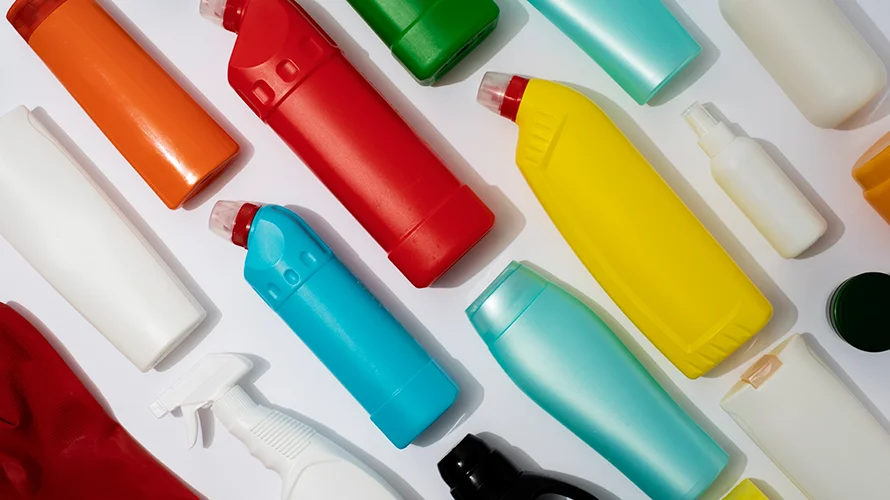
In today’s market of bottled products, different types of lids and caps are used to ensure proper containment, freshness, and security.
This article provides an overview of common types such as screw caps, child-proof caps, flip tops, spray heads, dispensing pumps, and more.
Understanding these options helps manufacturers choose the right closure for their products, while consumers gain insight into proper usage and storage.
This guide aims to offer concise and valuable information about these crucial components.
Standard Screw Caps
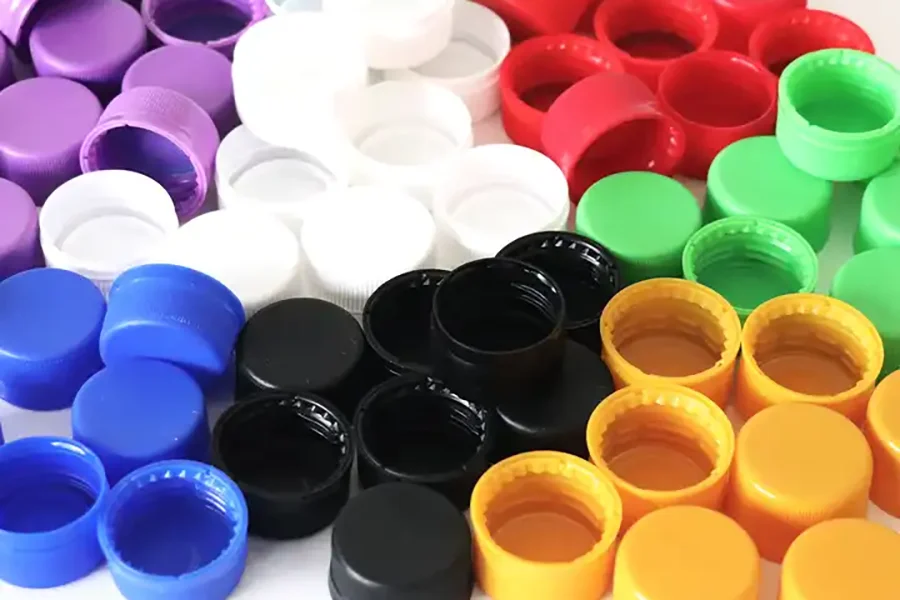
Features
Standard screw caps are the most common and recognizable form of bottle closure. They consist of a simple plastic or metal cap that screws onto the neck of the bottle. Standard screw caps form a secure seal and are easy to open and close with a twist. Many include an inner seal or liner to enhance freshness and prevent leakage. Standard caps come in a wide variety of sizes and styles to accommodate different bottle openings. They provide a versatile, effective, and inexpensive closure.
Uses
Standard screw caps are used on a broad range of products including food items, beverages, pharmaceuticals, household chemicals, automotive fluids, and more. Their simplicity and secure seal make them a reliable choice for containing liquids and preventing spills and contamination. Standard screw caps get used anytime an air-tight closure is needed and ease of opening/closing is desired.
Child Proof Caps
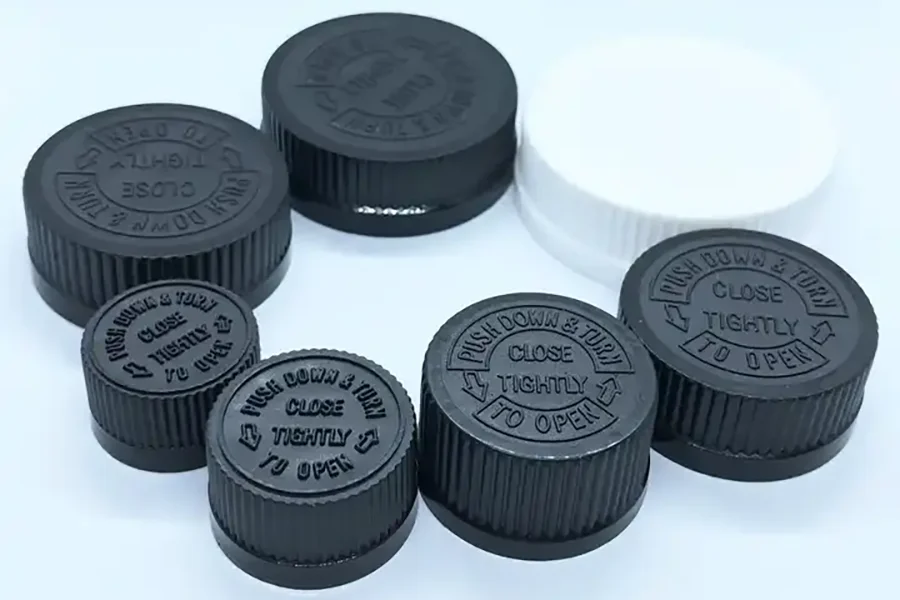
Features
Child proof caps provide an additional level of safety and security compared to standard screw caps. They contain a locking mechanism that requires pressing down while turning to open. This prevents children from easily opening potentially dangerous items like medicines. Child proof caps often use ratchet teeth inside the cap to integrate with teeth on the bottle neck. They may also include spring loading mechanisms. Color coding child proof caps is common.
Uses
Child proof caps are mandated for packaging of prescription drugs, OTC medicines, and household chemicals in many countries. They provide parents peace of mind by making it harder for kids to access items that could be hazardous if ingested. Child proofing is an important safety consideration for products that may cause harm if taken by accident.
Flip Top Caps
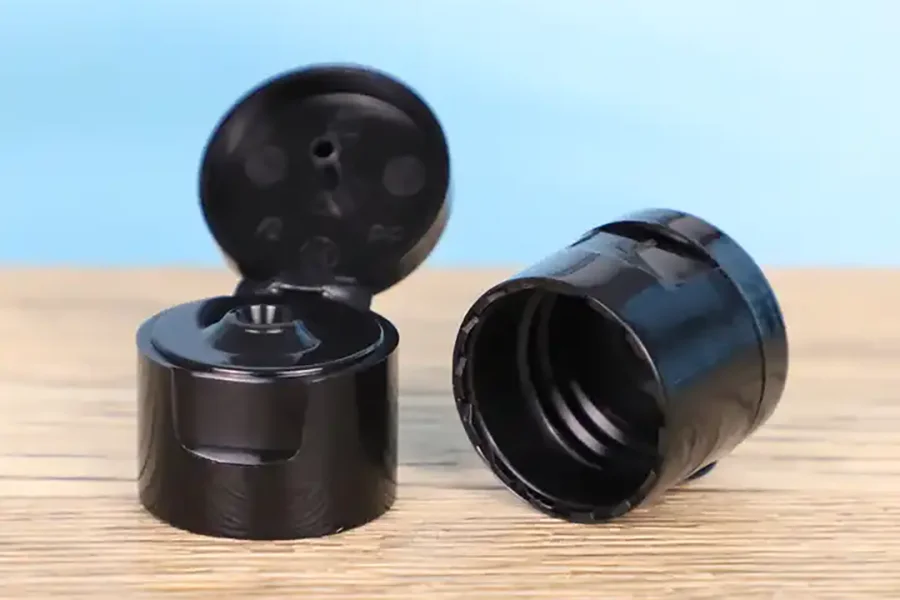
Features
Flip top caps offer convenient one-handed opening. They function by flipping up a small portion of the lid to reveal a dispensing opening. The flipped portion serves as a spout. Flip tops provide quick access without fully removing the entire lid. Hinges connect the flip portion to the base cap. Some include a re-closing cover over the opening.
Uses
Flip top caps are common for food products like ketchup or barbeque sauce as well as personal care items like shampoos or soaps. Their quick-access spout makes for easy pouring or dispensing. Flip tops are also useful for consumers opening products with one hand or who may struggle with grip strength to twist off closures.
Disc Top/Press Top Caps
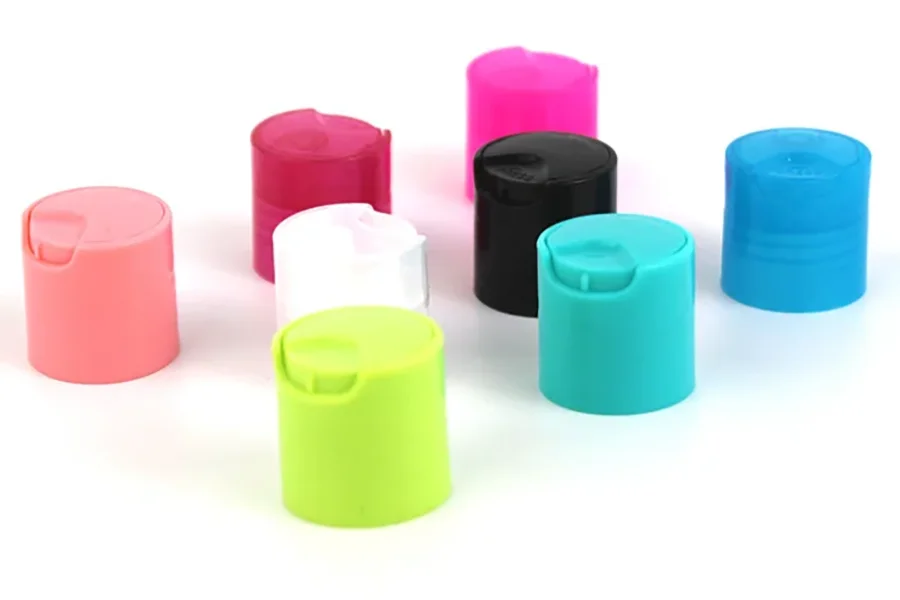
Features
Disc top caps provide easy, one-handed dispensing. They have a button on top that gets pressed down on one side to flip up the opposite side for pouring. The disc flips back to close. Disc tops often include a tamper evident pull tab seal for security. They are made from plastic and come in a variety of decorative styles.
Uses
Disc top caps are common for personal care products like shampoos, lotions, and soaps. Their ability to flip open with one hand makes them convenient in environments like the shower. Disc tops also work well for thick liquids like gels.
Sports Caps/Push-Pull Caps
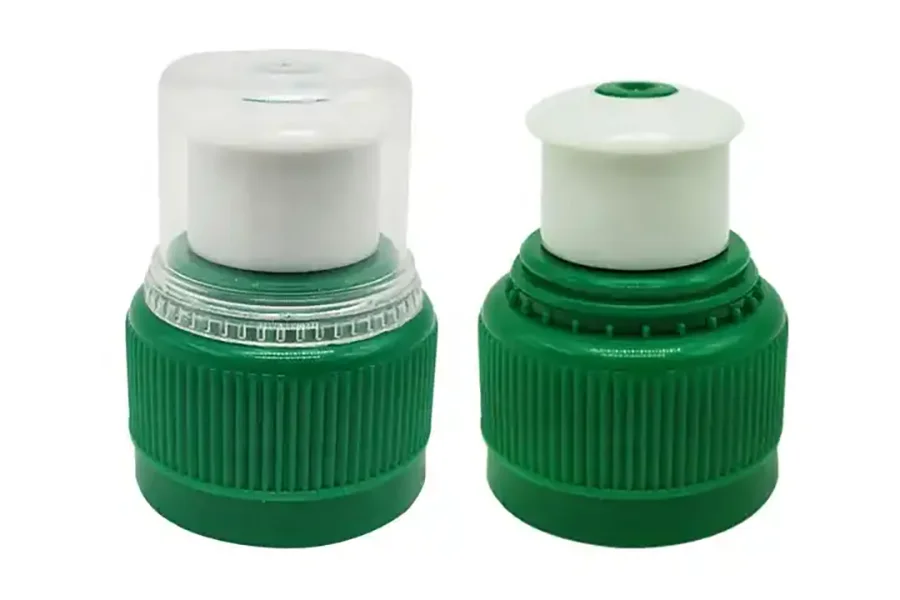
Features
Sports caps have a nozzle built into the lid that gets pulled up to open and pushed down to close. The nozzle locks into place when open. Sports caps allow drinking without removing the entire lid. The nozzle provides directed flow control. These caps are made from plastic and come in different opening sizes.
Uses
Sports caps are ideal for athletic hydration and sports drinks. Runners and bikers often use them to drink on the go. Sports caps also work well for household cleaners as they allow controlled dispensing. Their nozzle helps prevent accidental spilling and splashing.
Trigger Heads
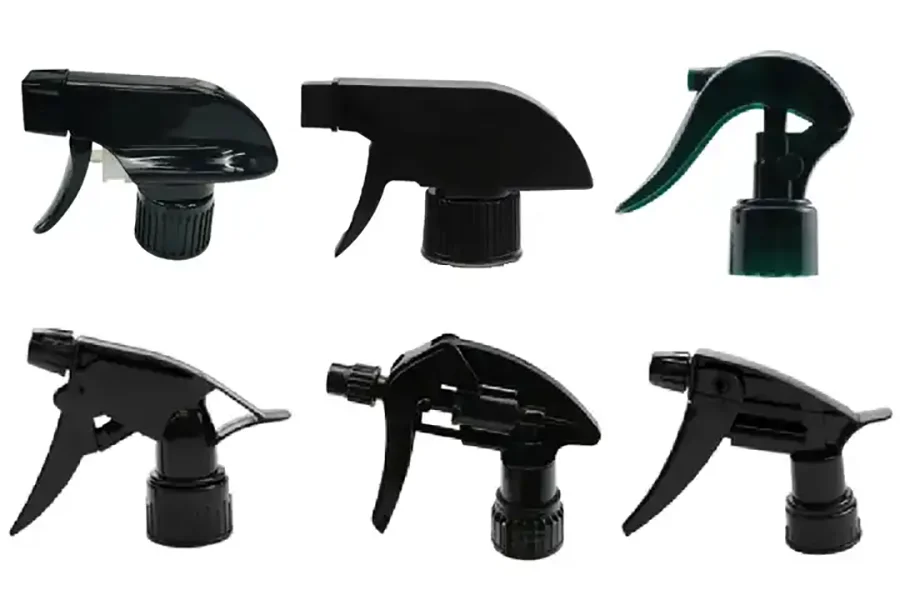
Features
Trigger heads have a trigger assembly built into the cap to dispense liquids through squeezing. They allow variable flow control. Trigger heads use a valve system that seals when not depressed. Rotating the trigger portion or entire cap locks it. Trigger heads are commonly made of plastic.
Uses
Trigger heads are ubiquitous for household cleaners like all-purpose sprays, window cleaners, and bathroom disinfectants. They allow controlled application of the product. Garden sprays also often use trigger heads. The ability to spray when needed makes trigger heads useful for a variety of cleaning and dispersing tasks.
Spray Caps
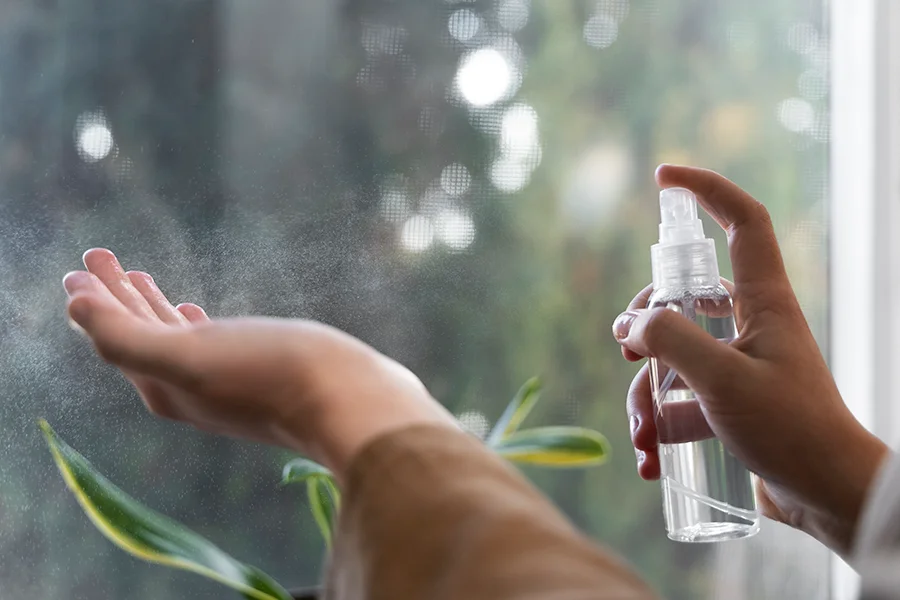
Features
Spray caps integrate a pump mechanism activated by pressing down on the cap. This dispenses a fine mist or stream. Spray caps provide mess-free dispensing and even distribution of product. They generally have a protective outer cap that prevents accidental spraying when not in use.
Uses
Spray caps are most commonly used for cosmetics and personal care like perfumes, deodorants, hairsprays, and sunscreens. They provide convenience and allow easy application. Spray caps are also seen on household cleaners, lubricants, and automotive products when a spray application is desired.
Pump Caps
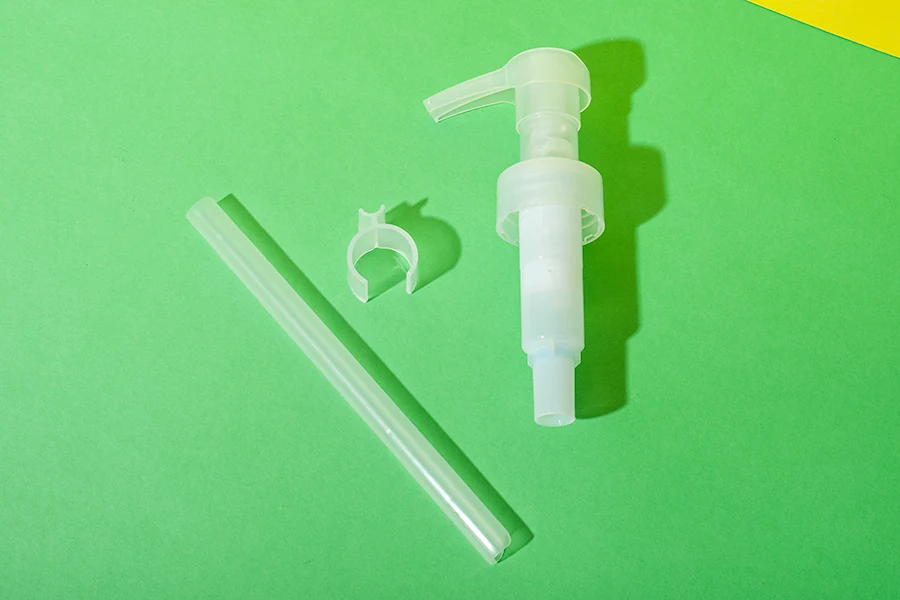
Features
Pump caps contain a pump mechanism that dispenses product through a nozzle when pressed. The pump head draws liquid up through a dip tube. Pumps allow measured dispensing and maintenance of product integrity. Pump caps often have a lock feature to prevent accidental discharge.
Uses
Pump caps are common for products like liquid hand soaps, lotions, sanitizers, and shampoos. Pumps allow easy, mess-free dispensing in controlled amounts. They help maintain product freshness by preventing contamination. Pumps also provide accessibility for those with limited grip strength.
Beer Bottle/Crown Caps

Features
Crown caps are metal lids that get crimped onto the lip of glass beer or soda bottles. They have a flat top and crimped edges that hold them in place. Crown caps provide a tight seal and are easy to remove with a bottle opener. Modern crown caps often have tamper evident bottom rims.
Uses
Crown style beer bottle caps have been used for over a century to seal in carbonation in beer and sodas. Their tight seal and ease of removal makes them ideal for glass bottling. Crown caps are the iconic closure expected on a bottle of beer. Their low cost and simple functionality keeps them prevalent.
Twist Top Caps
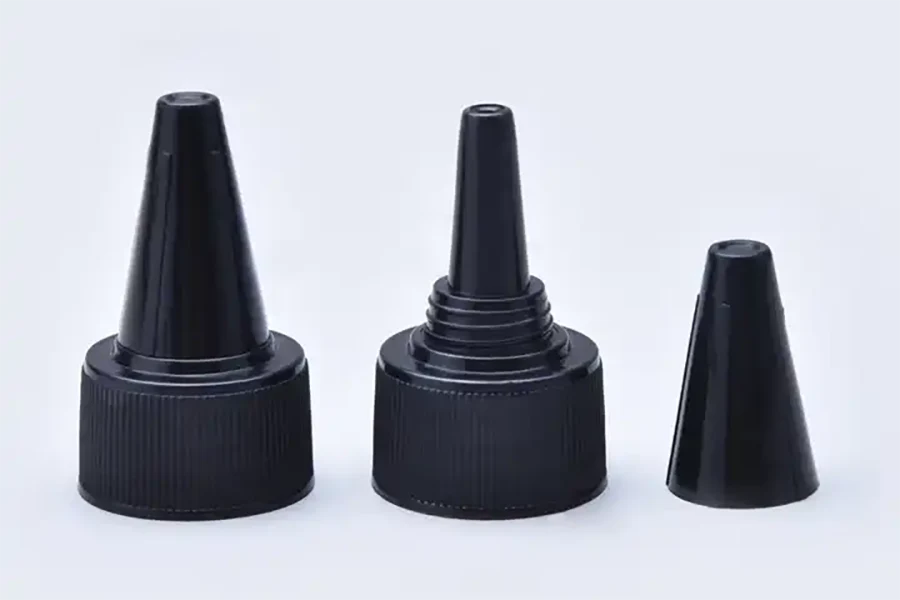
Features
Twist top caps have a threaded base and a screw-on rotating nozzle that dispenses product when turned. Opening and closing is controlled by twisting in either direction. Twist tops allow variable flow dispensing. The nozzle locks when closed to prevent leakage.
Uses
Twist top caps are common for condiments like ketchup, mustard, and hot sauce. They allow controlled dispensing and prevent mess. Twist tops are also seen on oils, sauces, and beauty products when directional dosing is desired.
ROPP Caps
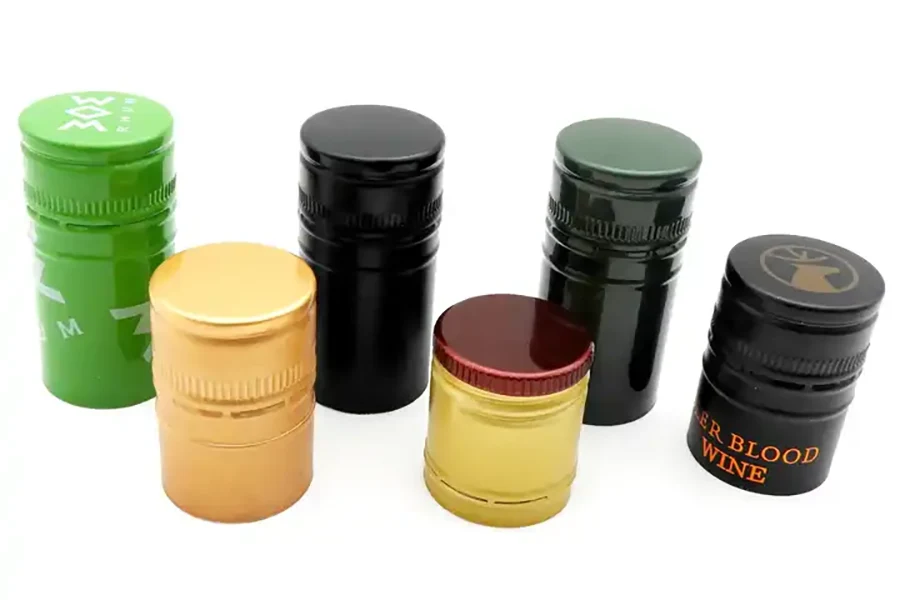
Features
ROPP (Roll On Pilfer Proof) caps are aluminum caps that get rolled onto bottle necks to form a tamper-evident seal. ROPP caps contain a warranty band that snaps upon first opening. They provide leak-proof closure and cannot be replaced once removed.
Uses
ROPP caps are prevalent in the wine and spirits industry due to their tamper-evidence and robust sealing. They help assure product integrity through distribution and retail. ROPP caps also get used for pharmaceuticals, oils, and household chemicals when tamper-proofing is important.
Corks

Features
Corks provide a traditional closure by getting compressed into bottle necks to form a tight seal. Natural cork is porous and allows gas exchange while preventing leakage. Synthetic corks mimic this capability. Corks form a strong friction hold and require a corkscrew for removal.
Uses
Corks are most associated with wine bottles but also seal some craft beers and spirits. The natural material provides time-tested closure. Corks allow product aging while maintaining a hermetic seal. Their classic look carries tradition and elegance that synthetic closures cannot replicate.
Eye Dropper Caps
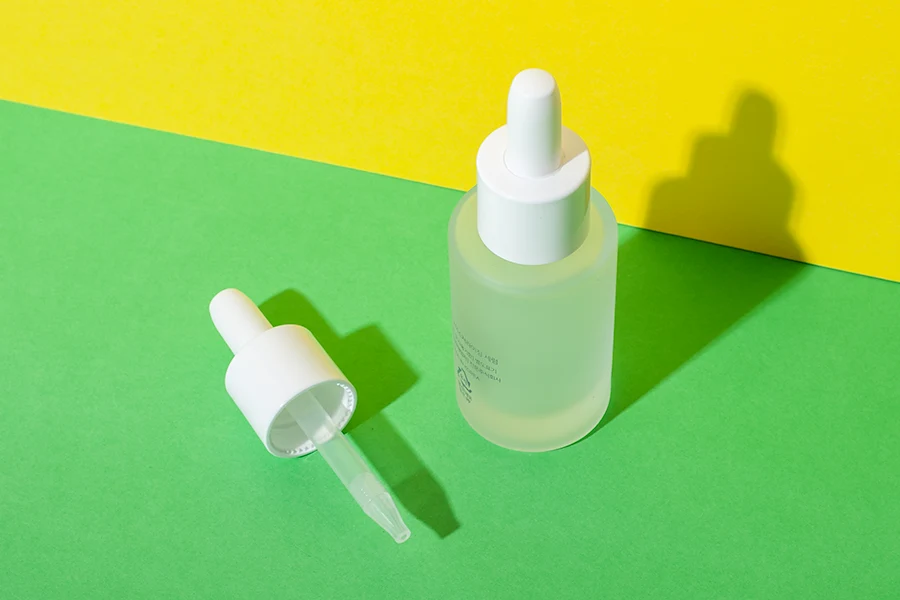
Features
Eye dropper caps contain a glass or plastic dropper for dispensing liquid in drops. The cap integrates a rubber bulb to draw liquid into the pipette. Eye droppers allow administration of precise volumes. They provide measurement markings on the pipette.
Uses
Eye dropper caps are essential for administering ophthalmic and otic medications. They allow accurate dosage into eyes or ears. Eye droppers also enable exact measurement for chemicals, reagents, and cosmetics when drop-wise addition is needed.
Flip Spout Caps
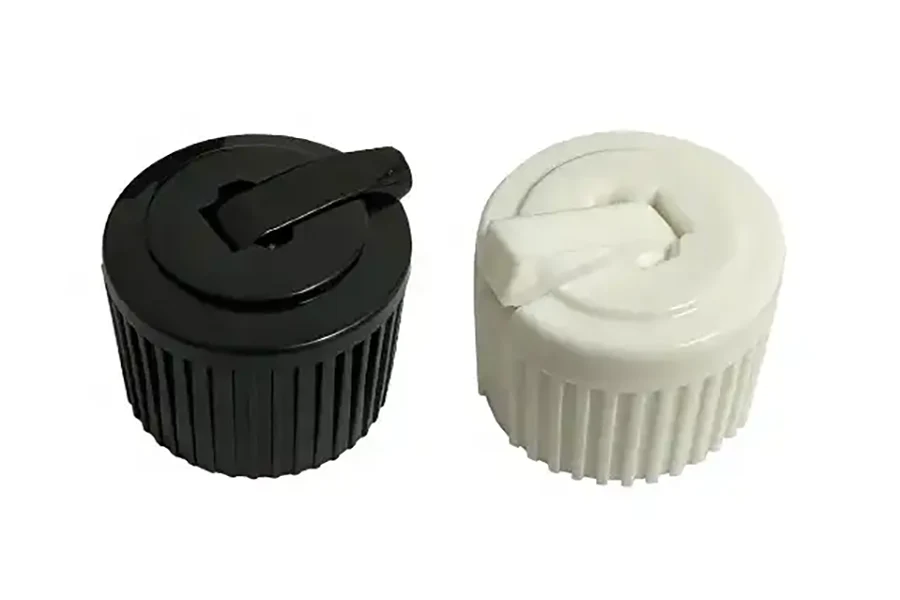
Features
Flip spout caps have a flip-up nozzle that dispenses liquid. They allow one-handed dispensing by flipping up the nozzle then closing it after use. Flip spouts have a hinge or pivot mechanism to open and close the nozzle.
Uses
Flip spout caps are common for thin liquids like vinegar, soy sauce, fuels, and cleaning chemicals. Their drip-resistant nozzle allows controlled pouring then resealing. Flip spouts are convenient for one-handed use in cooking and automotive applications.
Glue Caps
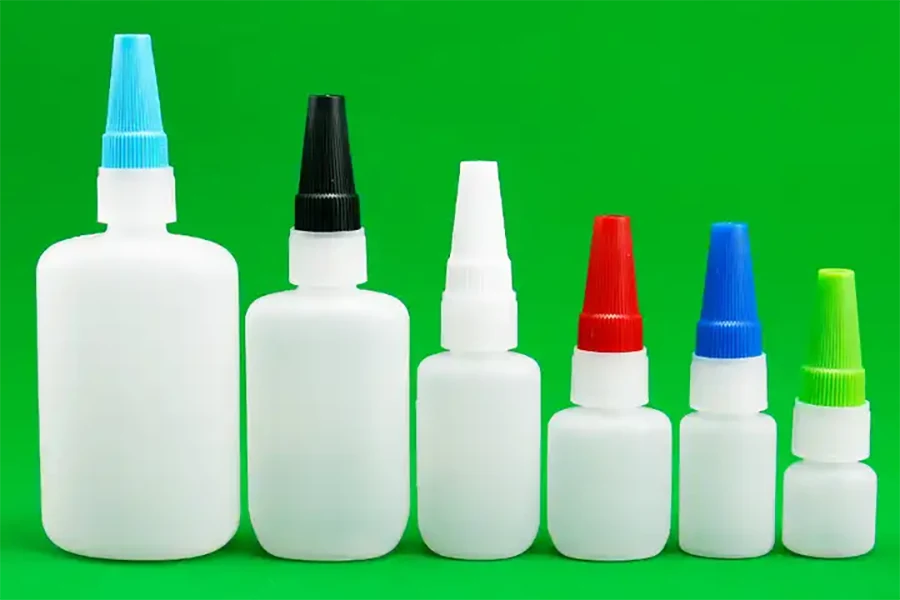
Features
Glue caps have an applicator tip designed for dispensing glues and adhesives. The application tip is optimized for viscous liquids. Channels in the tip allow product flow when squeezed. A secure lid keeps the applicator in place.
Uses
Glue caps are essential for bottling adhesives, epoxies, sealants, and other bonding products. The applicator tips allow controlled flow ideal for applying glue. Tight sealing prevents drying out between uses.
Yorker Caps
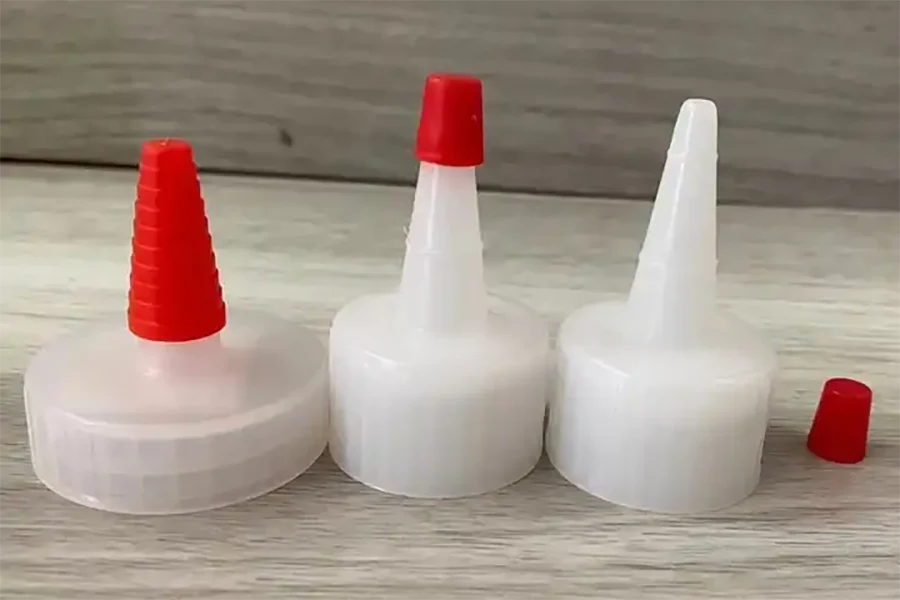
Features
Yorker caps, also called polycone caps, have a flexible cone-shaped spout for dispensing. The caps have a threaded base that attaches to bottles. An inner membrane constricts product flow. Biting the spout dispenses product.
Uses
Yorker caps are used for thick liquids like gels, creams, oils, and industrial lubricants where controlled dispensing is needed. Yorkers allow product to be squeezed out when desired then the membrane reseals. Condiments like honey and chocolate sauce often use Yorker caps.
Orifice Reducers
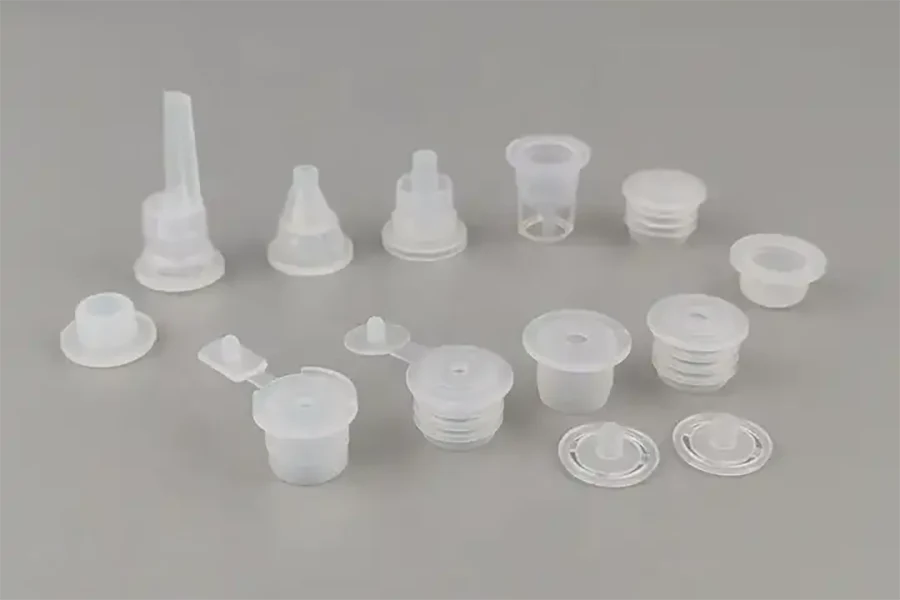
Features
Orifice reducers are plastic inserts that get pressed into the opening of bottles to shrink the discharge outlet. They have ribs that hold them in place. Orifice reducers provide adjustable flow control.
Uses
Orifice reducers help regulate the dispensing rate on condiment bottles, lotion pumps, and other containers. They allow producers to modify liquid flow without changing the entire cap. Reducers customize flow for product viscosity.
Tamper-Evident Caps
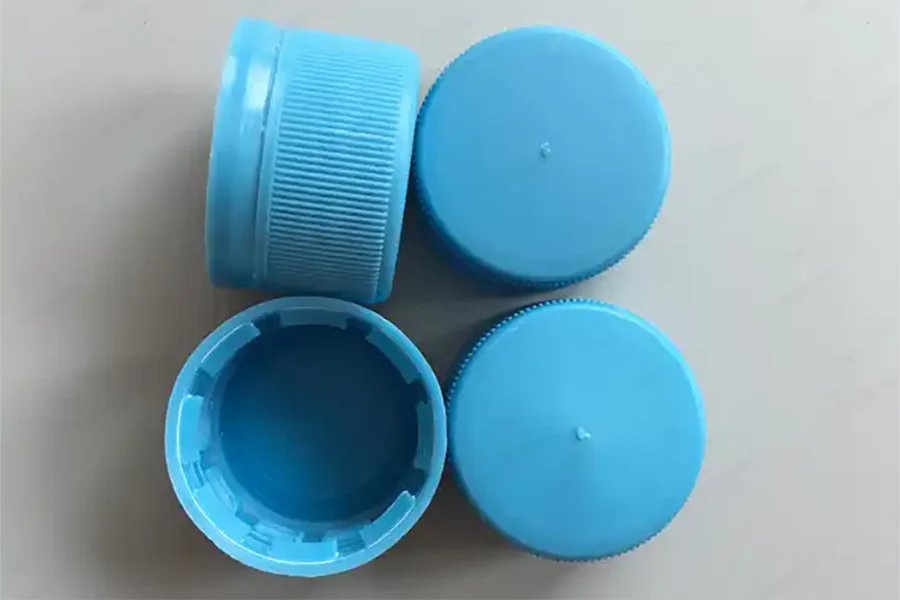
Features
Tamper-evident caps contain a safety seal that provides visual indication if a bottle has been opened. The seal may cover the cap/bottle junction or go under the cap. Breaking the seal gives evidence of tampering.
Uses
Tamper-evident caps are critical for pharmaceuticals, over-the-counter medicines, nutritional supplements and other products where purity is paramount. They provide consumers assurance that products are untainted.
Plastic Brush Caps
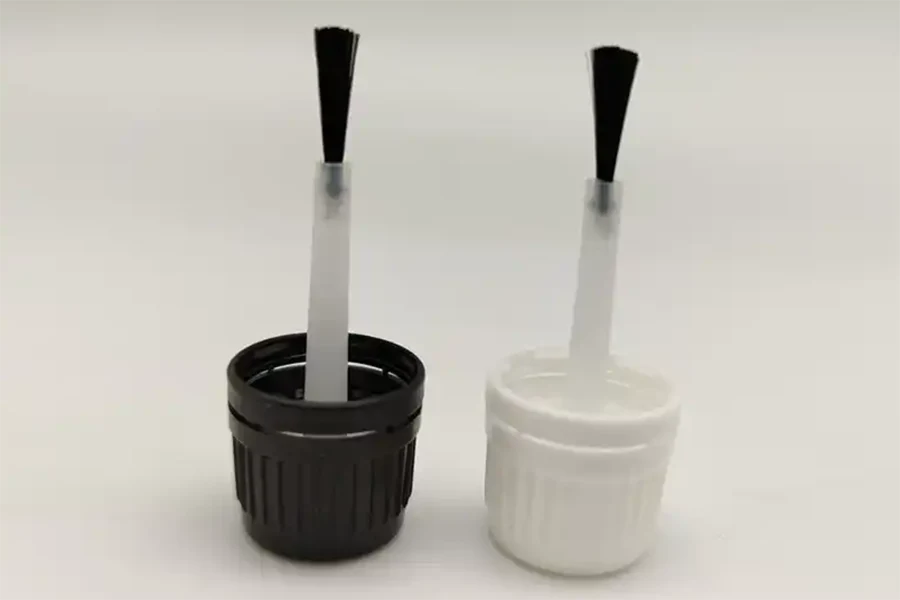
Features
Brush caps have a small built-in plastic brush applicator. The bristles allow controlled product application. Brush caps screw onto standard bottle openings. Bristle stiffness varies.
Uses
Brush caps are ideal for bottled glues, adhesives, nail polish, paints, and other art supplies where a brush is needed for product administration. The integrated brush eliminates mess and eases application.
Plastic Rod Caps
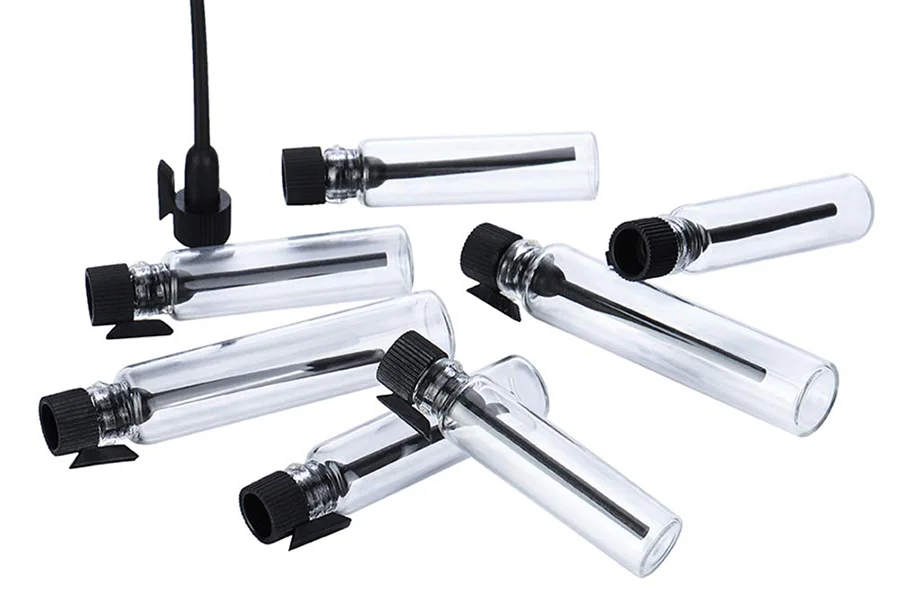
Features
Rod caps have a plastic rod tip inside the lid intended for product dispensing. The rod screws into caps with different tip configurations. Rods allow measured dosing.
Uses
Rod caps work well for essential oils, medications, and thick liquids where the rod can assist in dispensing precise amounts. Rod tips mitigate contamination and waste.
Sauce Bottle Caps
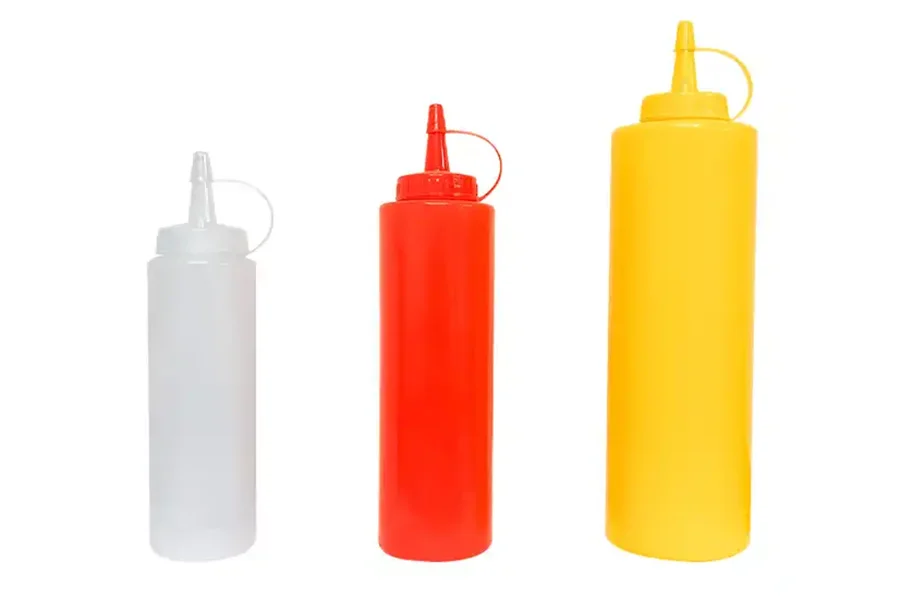
Features
Sauce bottle caps have a flip-top spout designed for condiment pouring and drizzling. The hinged spout can be opened then closed to prevent messes. Sauces bottles have wide mouths for easy refilling.
Uses
The sauce cap and bottle combination is ubiquitous for condiments like ketchup, mustard, and hot sauces. The sealing cap keeps food fresh while the flip-top allows easy access for pouring on foods.
Salt Bottle Caps
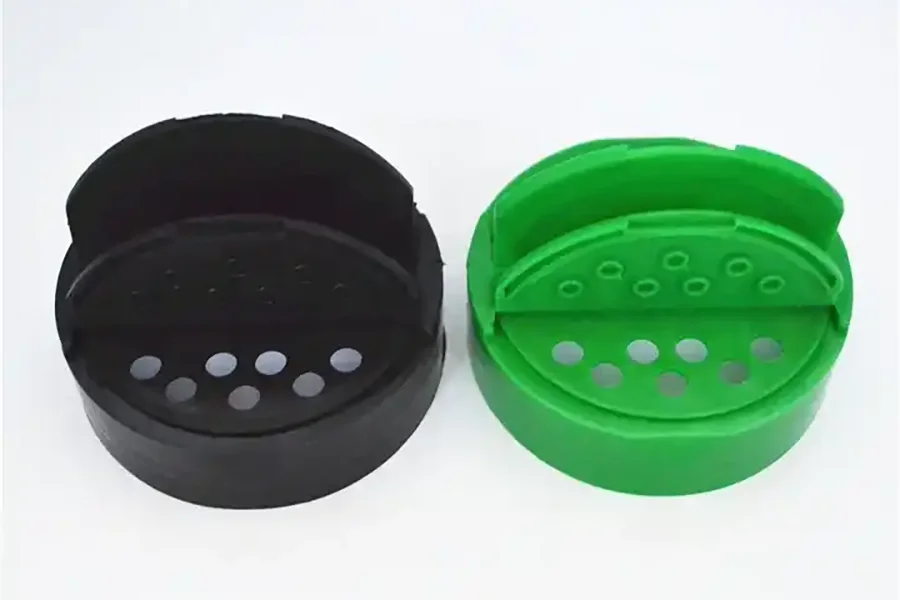
Features
Salt bottle caps have small holes or slots in the top for sprinkling salt granules when inverted. Salt bottles have large, wide openings with ribs for easy gripping. Salt caps seal tightly to keep contents dry.
Uses
Salt caps with shaker holes or slots get used table salt, cooking salt, and other salt-based seasoning products. The cap allows controlled seasoning while the wide bottle permits easy filling.
Spice Bottle Caps
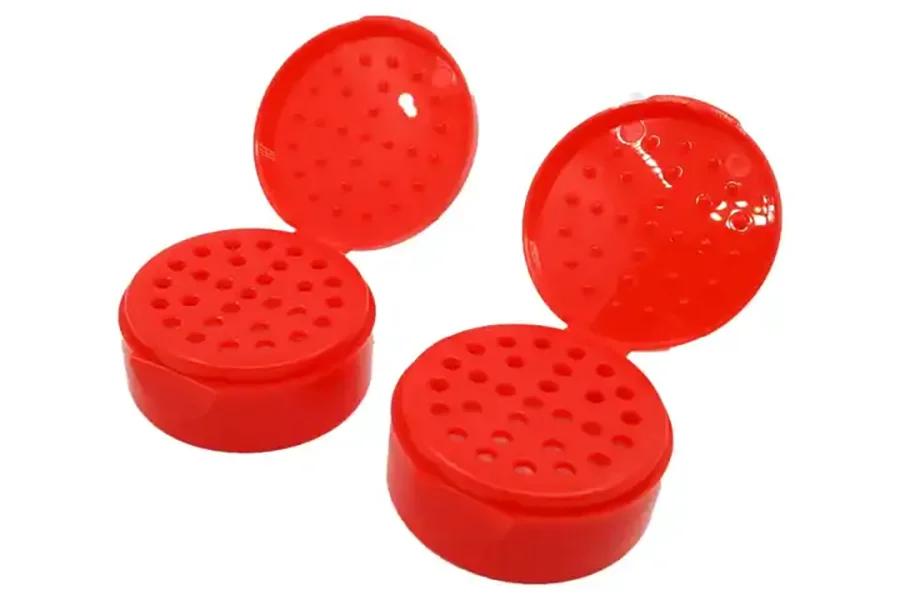
Features
Spice bottle caps integrate fine shaker holes for dusting spices. The caps flip open for refilling then securely close. Spice bottles typically have a cylindrical shape with orifices optimized for powder flow.
Uses
The spice cap and bottle combination provides convenient storage and shaking out of powdered spices. The full-flipping cap allows refills while the fine shaker regulates spice dosing.
Grinder Bottle Caps
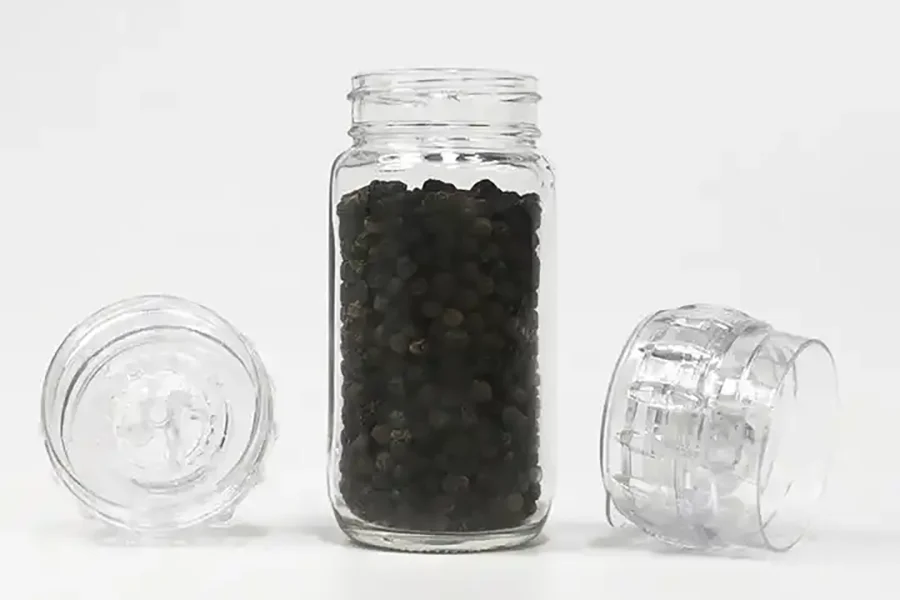
Features
Grinder bottle caps have mechanisms that grind whole spices into powder when turned. They contain abrasive surfaces and collection chambers. Grinder bottles are transparent for visibility.
Uses
Grinders allow fresh spices without the mess and waste of manual grinding. They are ideal for whole peppercorns, salt crystals, basil, and other dried spices. Grinders simplify flavoring food on the spot.
Syrup Dispensing Pumps
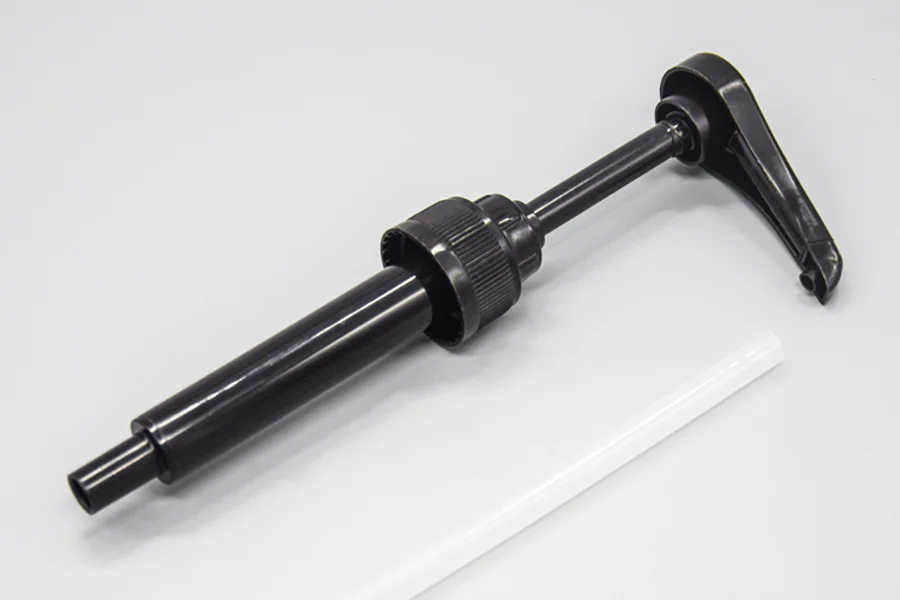
Features
Syrup dispensing pumps are designed to handle low viscosity liquids like flavored syrups. They have large orifices and valves optimized for thick flow. Some include a locking mechanism to prevent unwanted discharge. The pumps attach to wide mouth jars or bottles.
Uses
Syrup pumps allow controlled dispensing of viscous products like chocolate syrup, molasses, and pancake syrup from containers. They make it easy to drizzle and dose out just the needed amount of syrups, reducing waste. Locking features prevent messy leakage.
Sauce Dispensing Pumps
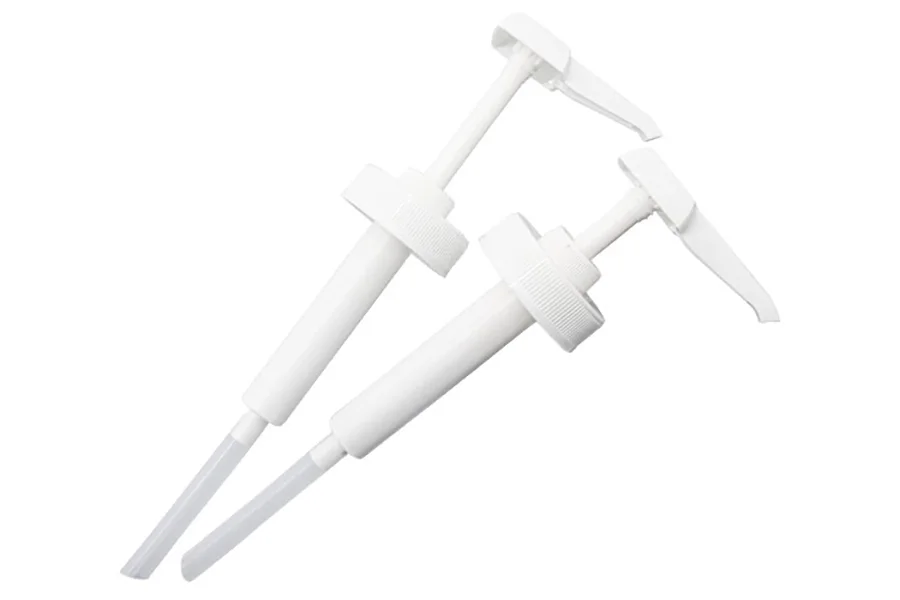
Features
Sauce dispensing pumps are optimized for condiments like ketchup, bbq sauce, soy sauce, and vinegar. Their valve configurations accommodate liquids with particulates. Drip-resistant nozzles keep messy drips contained after pouring. Sauce pumps include caps to keep food protected.
Uses
Sauce pumps enhance condiment convenience by allowing one-handed pumping onto foods. Their cap and nozzle design keeps messy drips contained while providing easy dosing of condiments. Sauce pumps simplify meal prep and dining.
Cleansing Oil or Makeup Remover Bottle Dispensing Pumps
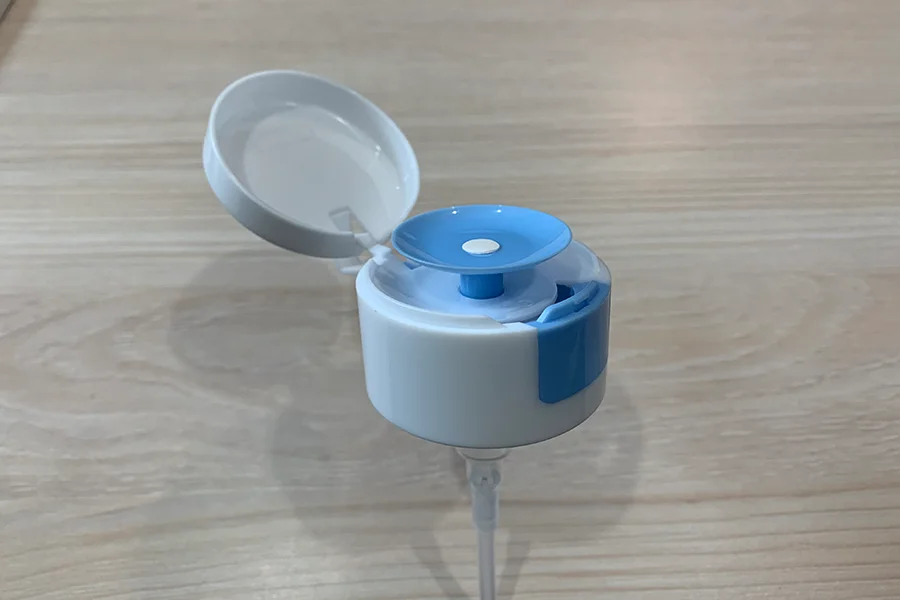
Features
Dispensing pumps for cleansing oils and makeup removers are designed not to clog from the thick oils and cosmetic residues. Wide flow channels prevent clogging. Slow-dripping nozzles dispense just what’s needed without waste. Protective caps keep pumps clean between uses.
Uses
These pumps are essential for handling cleansing oils and liquid cosmetic removers. The pumps prevent contamination while dispensing just enough product per use. Slow-flow nozzles allow control and prevent messy wasting of product.
UKPACK’s innovative makeup remover press bottle uses one-touch open design to improve the user experience.
The Importance of Choosing the Right Lid/Cap Type
Selecting the optimal cap or lid for a bottled product is critical for several reasons:
Preserving Product Integrity
The right cap or lid is essential for maintaining product stability and shelf life. Caps or lids that do not seal adequately can compromise product freshness and lead to spoilage or waste. Matching the closure to characteristics like ingredient sensitivity, processing method, and storage conditions helps keep products safe and effective.
Facilitating Proper Use
Choosing user-friendly caps or lids ensures customers can access, dispense, and reseal products easily. Caps that are overly complicated or require special tools to open can frustrate consumers. Selecting caps that dispense well with product viscosity enables proper dosing.
Preventing Accidents
For products with health or safety risks if ingested directly, the proper protective caps or lids are critical. Child-resistant caps help prevent accidental exposure or ingestion of medicines, chemicals, and supplements. Controlled dispensing caps like triggers and pumps limit contact.
Communicating Appropriate Use
The right cap or lid conveys appropriate usage to consumers based on category conventions. For example, spray triggers signal the product should be applied as a mist or spray. Pumps indicate measured dosing is intended. Familiar closures guide proper use.
Managing Costs
More complex dispensing caps or tamper-evident closures add expense compared to simple screw caps. Balancing cap capabilities with budget and target pricing is key. Over-investing in closures adds unnecessary costs.
By considering factors like product properties, target users, safety, desired access and dispensing, and costs, manufacturers can select the optimal caps and lids for their bottled products. The right closure improves consumer experience, prevents issues, and protects product integrity through distribution and use.
Conclusion
In summary, a diverse array of cap and lid types exist to appropriately contain and dispense bottled products. Standard screw caps provide reliable sealing while innovative options like flip tops, pumps, and triggers allow easier access and pouring. Child resistant caps add safety for potentially hazardous contents. The right closure balances utility, cost, and user experience.
When selecting products, consumers should consider cap types as insight into proper use and safety. Caps with protective seals indicate untampered contents. Measured dispensers like pumps and sticks should be applied sparingly and deliberately. Childproof caps warrant storage away from kids’ reach.
With this overview of common cap and lid varieties, their characteristics and intended uses are clarified. For manufacturers, understanding the options allows better pairings with product properties and user needs. Consumers gain insight into appropriate applications and storage of bottled goods. With knowledge of the many cap and lid types, readers can make informed choices for their own products and purchases.
Moving Forward with UKPACK
UKPACK stands ready as a professional packaging supplier to provide an extensive selection of cap and lid varieties for your product needs. Our experienced team can consult on the optimal closure solutions to match your product properties, convey proper use, and deliver great user experience.
Beyond caps and lids, UKPACK offers full-service packaging solutions. From bottles and containers to labels and sealing – we can provide a complete, integrated packaging system tailored to your specific product and market. With UKPACK as your packaging partner, you benefit from our expertise in packaging materials, manufacturing capabilities, and customer-focused approach.
Trust UKPACK as your single expert source for all packaging needs. We welcome the opportunity to collaborate from concept to completion in realizing impactful, efficient packaging that protects your products and delights your consumers. Contact UKPACK now.
